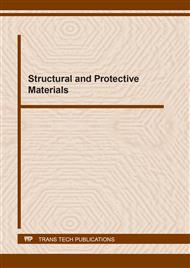[1]
Mauer, G., Jarligo, M.O., Rezanka, S., Hospach, A., Vaßen, R., Novel opportunities for thermal spray by PS-PVD, Surface and Coatings Technology, 268 (2015), pp.52-57.
DOI: 10.1016/j.surfcoat.2014.06.002
Google Scholar
[2]
Goral, M., Kotowski, S., Nowotnik, A., Pytel M., Drajewicz, M., Sieniawski, J., PS-PVD deposition of thermal barrier coatings, Surface and Coatings Technology, 237 (2013), 51–55.
DOI: 10.1016/j.surfcoat.2013.09.028
Google Scholar
[3]
Gao, L., Wei, L., Guo, H., Gong, S., Xu, H., Deposition mechanisms of yttria-stabilized zirconia coatings during plasma spray physical vapor deposition, Ceramics International, 42 (2016) 4, 5530-5536.
DOI: 10.1016/j.ceramint.2015.12.111
Google Scholar
[4]
Mauer, G., Hospach, A., Vaßen, R., Process development and coating characteristics of plasma spray-PVD, Surface and Coatings Technology, 220 (2013), 219–224.
DOI: 10.1016/j.surfcoat.2012.08.067
Google Scholar
[5]
Liu, M.-J., Zhang, M., Zhang, X.-F., Li G.-R., Zhang Q., Li C.-X., Li, C.-J., Yang, G.-J., Transport and deposition behaviors of vapor coating materials in plasma spray-physical vapor deposition, Applied Surface Science, 486 (2019), 80-92.
DOI: 10.1016/j.apsusc.2019.04.224
Google Scholar
[6]
Zhang, X., Zhou, K., Liu, M., , Deng, C., Deng, C., Deposition mechanism of 7YSZ thermal barrier coatings prepared by plasma spray-physical vapor deposition, Zhongguo Kexue Jishu Kexue/Scientia Sinica Technologica, 49 (2019) 11, 1319-1330.
DOI: 10.1007/s12598-018-1041-y
Google Scholar
[7]
Deng, Z.-Q., Mao, J., Liu, M., Deng, C.-M., Ma, J.-T., Regional characteristic of 7YSZ coatings prepared by plasma spray-physical vapor deposition technique, Rare Metals, 40 (2021)11, 3308-3315.
DOI: 10.1007/s12598-018-1041-y
Google Scholar
[8]
Zeng, W., Mao, J., Ma, J.-T., Deng C.-G., Deng Z.-Q., Deng, C.-M., Song, P., Effect of surface roughness on deposition of PS-PVD thermal barrier coating ceramic coating, Cailiao Gongcheng/Journal of Materials Engineering, 47 (2019)8, 161-168.
Google Scholar
[9]
Chen, W., Liu, M., Zhang, J., Deng. Z, Xiao, X., Tang, W., 12 Impedance Spectroscopy Analysis of 7YSZ Thermal Barrier Coatings Prepared by Plasma Spray-Physical Vapor Deposition During the High-temperature Oxidation Process, Cailiao Daobao/Materials Reports, 33 (2019) 2, 602-606.
DOI: 10.1016/j.cja.2017.12.008
Google Scholar
[10]
Schmitt, M.P., Harder, B.J., Wolfe, D.E., Process-structure-property relations for the erosion durability of plasma spray-physical vapor deposition (PS-PVD) thermal barrier coatings, Surface and Coatings Technology, 297 (2016), 11-18.
DOI: 10.1016/j.surfcoat.2016.04.029
Google Scholar
[11]
Gao, L., Guo, H., Wei, L., Li, C., Xu, H., Microstructure, thermal conductivity and thermal cycling behavior of thermal barrier coatings prepared by plasma spray physical vapor deposition, Surface and Coatings Technology 276 (2015), 424-430.
DOI: 10.1016/j.surfcoat.2015.06.033
Google Scholar
[12]
Qiu, S.-Y., Shi, J., Li, S., , Ma, Y., Guo, H.-B., Model on thermal conductivity prediction of quasi-columnar structured coating by plasma spray physical vapor deposition, Ceramics International, 2021 in press.
DOI: 10.1016/j.ceramint.2021.06.164
Google Scholar
[13]
Kumar, N., Gupta, M., Mack, D.E., Mauer, G., Vaßen, R., Columnar Thermal Barrier Coatings Produced by Different Thermal Spray Processes, Journal of Thermal Spray Technology, 30 (2021)6, 1437-1452.
DOI: 10.1007/s11666-021-01228-5
Google Scholar
[14]
Goral, M., Kotowski, S., Sieniawski, J., The technology of plasma spray physical vapour deposition, High Temperature Materials and Processes, 2013, 32(1), 33–39.
DOI: 10.1515/htmp-2012-0051
Google Scholar
[15]
Goral, M., Pytel, M., Sosnowy, P., Kotowski, S., Drajewicz, M., Microstructural characterization of thermal barrier coatings deposited by APS and LPPS thin film methods, Solid State Phenomena, 197 (2013), 1–5.
DOI: 10.4028/www.scientific.net/ssp.197.1
Google Scholar
[16]
Goral, M., Kubaszek, T., The influence of process parameters on structure of ceramic coatings deposited by PS-PVD method, Solid State Phenomena, 267(2017), 243–247.
DOI: 10.4028/www.scientific.net/ssp.267.243
Google Scholar
[17]
Drajewicz, M., Dychtoń, K., Góral, M. Thermal properties of YSZ powders for plasma spraying, Solid State Phenomena, 2015, 227, 413–416.
DOI: 10.4028/www.scientific.net/ssp.227.413
Google Scholar
[18]
Dychtoń, K., Drajewicz, M., Pytel, M., Rokicki, P., Nowotnik, A., Yttria-stabilized zirconia–alumina composite sintering temperature effect on thermal diffusivity, Journal of Thermal Analysis and Calorimetry,126(2016)1, 1-7.
DOI: 10.1007/s10973-016-5788-9
Google Scholar
[19]
Chen, W.-L., Wu, H.-J., Liu, M., Xiao, X.-L., Erosion behaviour of ps-pvd thermal barrier coatings and the effect of composite coating (Ps-pvd + aps) thickness, Materials Science Forum, 993 (2020), 1095-1103.
DOI: 10.4028/www.scientific.net/msf.993.1095
Google Scholar
[20]
Nowotnik, A., Goral, M., Pytel, M., Dychton, K., Influence of coatings deposition parameters on microstructure of aluminide coatings deposited by CVD method on Ni-superalloys, Solid State Phenomena, 197 (2013), 95–100.
DOI: 10.4028/www.scientific.net/ssp.197.95
Google Scholar
[21]
Moskal, G, Microstructure and thermal diffusivity of micro- and nano- sized YSZ, Materials Science Forum, 638-642 (2010), 900-905.
DOI: 10.4028/www.scientific.net/msf.638-642.900
Google Scholar
[22]
Moskal, G., Thermal diffusivity of TBC layers of RE2Zr2O7 type, Defect and Diffusion Forum, 312-315 (2011), 445-450.
DOI: 10.4028/www.scientific.net/ddf.312-315.445
Google Scholar
[23]
Pędrak, P., Dychtoń, K., Drajewicz, M., Góral, M., Synthesis of Gd2Zr2O7 coatings using the novel reactive ps-pvd process, Coatings, 2021, 11(10), 1208,.
DOI: 10.3390/coatings11101208
Google Scholar


